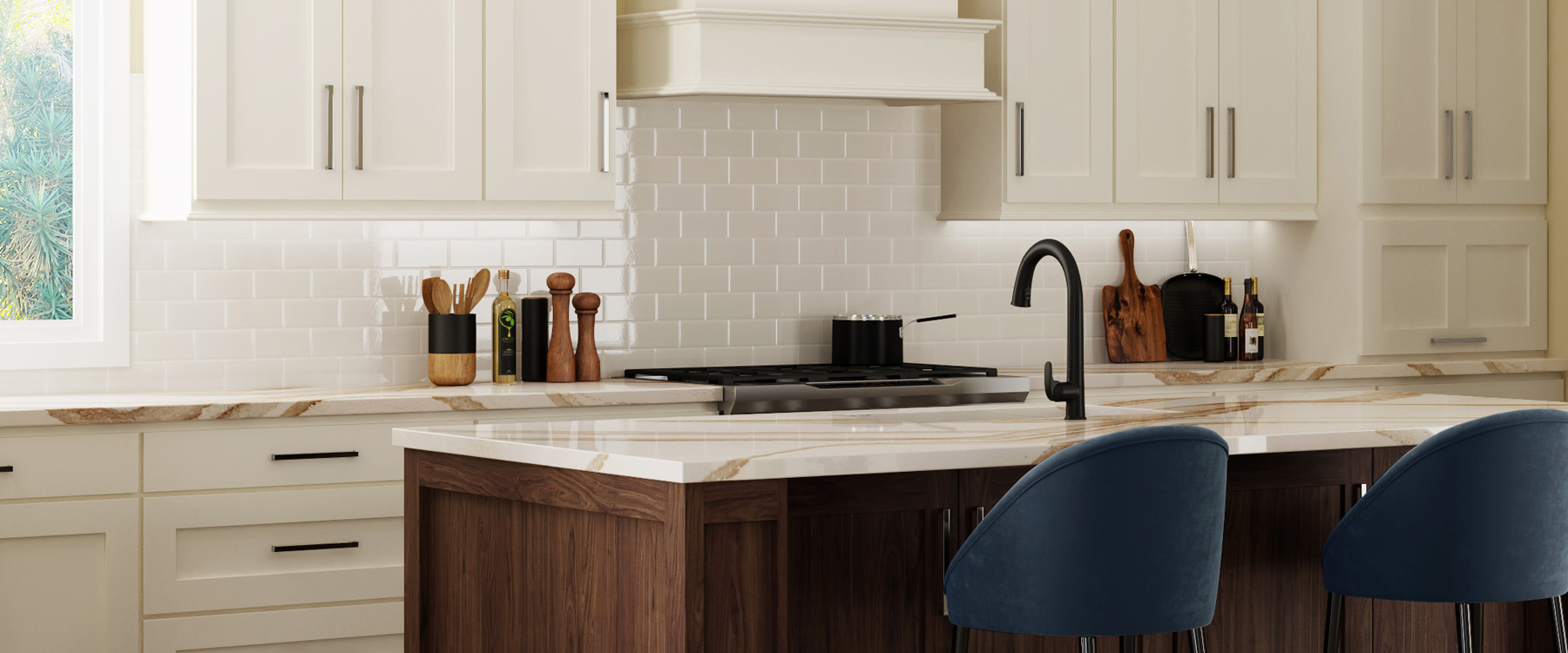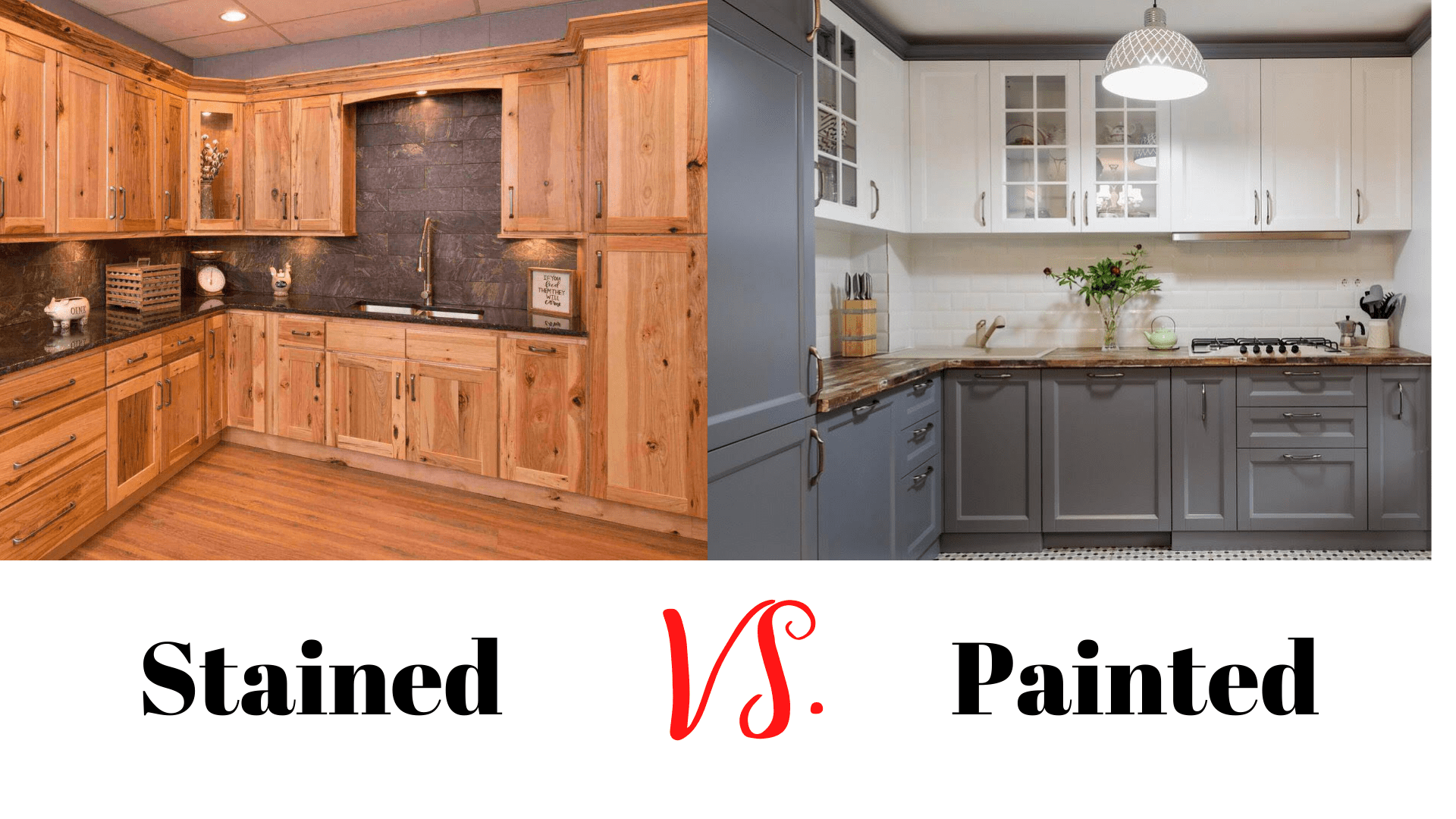Aesthetics and Style Comparisons

The choice between stained and painted kitchen cabinets significantly impacts the overall aesthetic and style of a kitchen. Stained cabinets showcase the natural beauty of the wood grain, while painted cabinets offer a wider range of colors and a more uniform finish. The optimal choice depends heavily on the desired kitchen style and the homeowner’s personal preferences.
Stained cabinets vs painted cabinets – Understanding the visual differences between stained and painted cabinets, and how these choices harmonize with various kitchen styles, is crucial for achieving a cohesive and aesthetically pleasing design. This analysis will explore the visual appeal of each option across different kitchen styles, detailing complementary color palettes and the effects of various wood stains.
Cabinet Styles and Color Palettes
The following table illustrates how stained and painted cabinets integrate into various kitchen styles.
| Kitchen Style | Stained Cabinets Example | Painted Cabinets Example | Color Palette Examples |
|---|---|---|---|
| Traditional | Dark cherry wood with a satin finish, showcasing rich grain patterns. | Creamy white or off-white, evoking a sense of classic elegance. | Warm earth tones (browns, beiges), accented with deep greens or blues. Warm whites with gold accents. |
| Modern | Light-colored wood like maple or ash with a clear or light stain, emphasizing clean lines. | Sleek gray or black, creating a minimalist and sophisticated atmosphere. | Monochromatic schemes (variations of gray or beige), or bold accent colors like emerald green or deep navy. Neutral colors with pops of bright color. |
| Farmhouse | Reclaimed wood with a natural, rustic finish, highlighting imperfections and texture. | Soft, muted colors such as pale blue or sage green, providing a comforting and relaxed feel. | Natural, muted tones (whites, creams, light grays) paired with natural wood tones. Soft pastel shades with pops of brighter colors. |
Color Palette Moods
Color palettes play a significant role in setting the mood of a kitchen. For example, a warm palette with stained cabinets in rich wood tones, such as walnut or cherry, can create a feeling of coziness and traditional elegance. This is often achieved with warm earth tones like terracotta, mustard yellow, and deep reds. Conversely, a cool palette with painted cabinets in light gray or blue can create a clean, airy, and modern feel. This is commonly seen in kitchens with shades of light gray, pale blues, and whites.
Wood Stain Types and Their Effects
The choice of wood stain dramatically influences the final appearance of stained cabinets. Different stains offer varied colors, finishes, and degrees of grain enhancement.
Selecting the appropriate stain requires careful consideration of the desired aesthetic and the type of wood being used. The stain’s impact on the overall look of the cabinets is substantial, and should be considered carefully.
- Water-Based Stains: Easier cleanup, faster drying time, less odor, and generally produce a more transparent finish, allowing the wood grain to show through prominently.
- Oil-Based Stains: Deeper penetration into the wood, richer color, and more durable finish, but require longer drying times and more thorough cleanup.
- Gel Stains: Thicker consistency, less likely to run or drip, ideal for vertical surfaces, and offer excellent color coverage but can mask the wood grain more than other types.
- Nitorcellulose Lacquer Stains: Provide a fast-drying, hard, durable finish with excellent color saturation. However, these stains require specialized application techniques.
Durability and Maintenance: Stained Cabinets Vs Painted Cabinets

The choice between stained and painted kitchen cabinets significantly impacts their long-term durability and the associated maintenance requirements. Understanding these differences is crucial for making an informed decision that aligns with your lifestyle and budget. Both finishes offer advantages and disadvantages concerning longevity and upkeep, which will be detailed below.
The maintenance and longevity of both stained and painted cabinets are influenced by several factors, including the quality of materials used, the application process, and the level of care provided by the homeowner. Proper preparation and application of the finish are paramount to maximizing the lifespan of the cabinets.
Maintenance Requirements
Regular cleaning and prompt attention to damage are essential for preserving the appearance and structural integrity of both stained and painted cabinets. Different cleaning methods and repair techniques are necessary for each finish type. The following Artikels the specific requirements:
- Stained Cabinets: Cleaning typically involves wiping with a damp cloth and mild detergent. Avoid abrasive cleaners or excessive moisture, as these can damage the wood and stain. Scratches can be lightly sanded and re-stained, while more significant damage may require professional refinishing. Regular conditioning with wood oil can help maintain the wood’s moisture content and prevent cracking.
- Painted Cabinets: Cleaning is generally easier, often involving a damp cloth and mild detergent. Avoid harsh chemicals or abrasive scrubbers that can scratch the paint. Minor chips or scratches can often be touched up with paint, while more extensive damage may necessitate professional repainting or refinishing. Regular cleaning will help to prevent build-up of grease and grime which could damage the paint over time.
Longevity of Finishes
The lifespan of each cabinet finish varies depending on usage and maintenance. Both are susceptible to damage, but the nature of that damage differs, as does the ease of repair.
- Stained Cabinets: Stained cabinets are susceptible to scratches, dents, and water damage. The wood itself can also be prone to warping or cracking if not properly maintained. However, with proper care, a well-stained cabinet can last for decades. Scratches may show more prominently than on painted surfaces.
- Painted Cabinets: Painted cabinets are generally more resistant to scratches and dents than stained cabinets. However, the paint can chip or peel over time, especially in high-traffic areas. UV exposure can cause fading, requiring repainting. Repairing chips is usually simpler than repairing scratches on stained wood.
Cost Comparison of Maintenance Over Time
The long-term cost of maintaining cabinets depends on the frequency of repairs and the cost of materials and labor. While initial costs might be comparable, the ongoing maintenance can differ significantly.
| Cost Category | Stained Cabinets | Painted Cabinets | Notes |
|---|---|---|---|
| Minor Repair (scratch/chip) | $25 – $100 (materials and labor, depending on severity) | $10 – $50 (touch-up paint) | DIY repairs are often possible for painted cabinets, reducing costs. |
| Refinishing | $300 – $1000+ per cabinet (depending on size and complexity) | $200 – $800+ per cabinet (depending on size and complexity) | Professional refinishing is generally more expensive for stained cabinets due to the need for sanding and re-staining. |
| Annual Maintenance | $50 – $100 (wood conditioner, cleaning supplies) | $25 – $50 (cleaning supplies) | This accounts for the cost of cleaning supplies and occasional conditioning for stained cabinets. |
| Complete Replacement | $500 – $1500+ per cabinet | $500 – $1500+ per cabinet | Costs vary significantly based on cabinet style, size, and material. |
Cost and Installation
The decision between stained and painted kitchen cabinets significantly impacts the overall project cost. This section details the expense breakdown for both options, encompassing materials and labor, and identifies factors influencing the final price. Understanding these costs is crucial for budgeting and making informed decisions during a kitchen renovation.
A comprehensive cost analysis must consider various factors. While initial material costs may seem straightforward, labor costs, cabinet quality, and the chosen finish significantly affect the overall expense.
Cost Breakdown of Stained and Painted Cabinets
The following table provides a general cost estimate for stained and painted cabinets. Remember that these are averages and actual costs can vary based on location, contractor, and project specifics. Always obtain multiple quotes before committing to a project.
| Item | Stained Cabinets | Painted Cabinets | Notes |
|---|---|---|---|
| Cabinet Purchase (per linear foot) | $150 – $300 | $120 – $250 | Price varies significantly based on wood type, quality, and style. |
| Installation (per linear foot) | $75 – $150 | $75 – $150 | Installation costs are relatively similar for both finishes. |
| Finishing (per linear foot) | $50 – $100 | $40 – $80 | Staining generally requires more specialized labor and potentially higher-quality materials. |
| Total (per linear foot) | $275 – $550 | $235 – $480 | These are estimates and can vary considerably. |
Factors Influencing Cabinet Costs
Several factors can significantly impact the overall cost of your cabinet project. Careful consideration of these elements is essential for accurate budgeting and realistic project planning.
- Cabinet Quality: High-quality, custom cabinets will cost significantly more than ready-to-assemble (RTA) or stock cabinets. Solid wood construction commands a higher price than particleboard or MDF.
- Wood Type: The type of wood used directly influences the price. Exotic hardwoods like cherry or mahogany are considerably more expensive than more common woods such as maple or oak.
- Paint/Stain Choices: High-end paints and stains, or those requiring multiple coats, increase the overall cost. The complexity of the finish also affects labor costs.
- Cabinet Style and Design: Intricate designs and custom features add to both material and labor costs. Simple shaker-style cabinets will be less expensive than ornate, detailed designs.
- Labor Costs: Regional variations in labor rates, contractor experience, and project complexity significantly influence labor costs. Highly skilled professionals often charge more.
Cost Comparison Chart: Cabinet Options, Stained cabinets vs painted cabinets
The following table compares the approximate costs of various cabinet options. These are broad estimates, and actual prices will depend on specific features and project details. Consulting with multiple contractors is recommended to obtain accurate pricing.
| Cabinet Type | Wood Type | Stained (per linear foot) | Painted (per linear foot) |
|---|---|---|---|
| Stock Cabinets | Oak | $200 – $300 | $175 – $250 |
| Semi-Custom Cabinets | Maple | $250 – $400 | $225 – $350 |
| Custom Cabinets | Cherry | $400 – $700+ | $350 – $600+ |
| RTA Cabinets | MDF | $100 – $200 | $80 – $175 |
